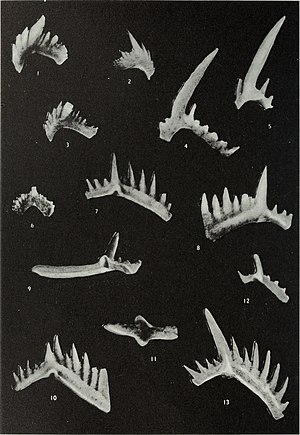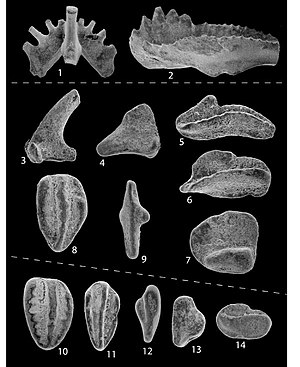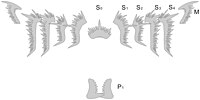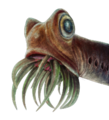Conodont
Conodonts (Greek kōnos, "cone", + odont, "tooth") are an extinct group of agnathan (jawless) vertebrates resembling eels, classified in the class Conodonta. For many years, they were known only from their tooth-like oral elements, which are usually found in isolation and are now called conodont elements. Knowledge about soft tissues remains limited. They existed in the world's oceans for over 300 million years, from the Cambrian to the beginning of the Jurassic. Conodont elements are widely used as index fossils, fossils used to define and identify geological periods.
| Conodonts Temporal range: | |
|---|---|
 | |
| Conodont elements | |
| Scientific classification | |
| Domain: | Eukaryota |
| Kingdom: | Animalia |
| Phylum: | Chordata |
| Subphylum: | Vertebrata |
| Class: | †Conodonta Pander, 1856 |
| Subgroups | |
| |
| Synonyms | |
| |
Discovery and understanding of conodonts
The teeth-like fossils of the conodont were first discovered by Heinz Christian Pander and the results published in Saint Petersburg, Russia, in 1856.
It was only in the early 1980s that the first fossil evidence of the rest of the animal was found (see below). In the 1990s exquisite fossils were found in South Africa in which the soft tissue had been converted to clay, preserving even muscle fibres. The presence of muscles for rotating the eyes showed definitively that the animals were primitive vertebrates.
Nomenclature and taxonomic rank
Through their history of study, "conodont" is a term which has been applied to both the individual fossils and to the animals to which they belonged. The original German term used by Pander was "conodonten", which was subsequently anglicized as "conodonts", though no formal latinized name was provided for several decades. MacFarlane (1923) described them as an order, Conodontes (a Greek translation), which Huddle (1934) altered to the Latin spelling Conodonta. A few years earlier, Eichenberg (1930) established another name for the animals responsible for conodont fossils: Conodontophorida ("conodont bearers"). A few other scientific names were rarely and inconsistently applied to conodonts and their proposed close relatives during 20th century, such as Conodontophoridia, Conodontophora, Conodontochordata, Conodontiformes, and Conodontomorpha.
Conodonta and Conodontophorida are by far the most common scientific names used to refer to conodonts, though inconsistencies regarding their taxonomic rank still persist. Bengtson (1976)'s research on conodont evolution identified three morphological tiers of early conodont-like fossils: protoconodonts, paraconodonts, and "true conodonts" (euconodonts). Further investigations revealed that protoconodonts were probably more closely related to chaetognaths (arrow worms) rather than true conodonts. On the other hand, paraconodonts are still considered a likely ancestral stock or sister group to euconodonts.
The 1981 Treatise on Invertebrate Paleontology volume on the conodonts (Part W revised, supplement 2) lists Conodonta as the name of both a phylum and a class, with Conodontophorida as a subordinate order for "true conodonts". All three ranks were attributed to Eichenberg, and Paraconodontida was also included as an order under Conodonta. This approach was criticized by Fåhraeus (1983), who argued that it overlooked Pander's historical relevance as a founder and primary figure in conodontology. Fåhraeus proposed to retain Conodonta as a phylum (attributed to Pander), with the single class Conodontata (Pander) and the single order Conodontophorida (Eichenberg). Subsequent authors continued to regard Conodonta as a phylum with an ever-increasing number of subgroups.
With increasingly strong evidence that conodonts lie within the phylum Chordata, more recent studies generally refer to "true conodonts" as the class Conodonta, containing multiple smaller orders. Paraconodonts are typically excluded from the group, though still regarded as close relatives. In practice, Conodonta, Conodontophorida, and Euconodonta are equivalent terms and are used interchangeably.
Conodont elements
Lone elements
Conodont elements consist of mineralised teeth-like structures of varying morphology and complexity. The evolution of mineralized tissues has been puzzling for more than a century. It has been hypothesized that the first mechanism of chordate tissue mineralization began either in the oral skeleton of conodonts or the dermal skeleton of early agnathans.
The element array constituted a feeding apparatus that is radically different from the jaws of modern animals. They are now termed "conodont elements" to avoid confusion. The three forms of teeth, i.e., coniform cones, ramiform bars, and pectiniform platforms, probably performed different functions.
For many years, conodonts were known only from enigmatic tooth-like microfossils (200 micrometers to 5 millimeters in length), which occur commonly, but not always, in isolation and were not associated with any other fossil. Until the early 1980s, conodont teeth had not been found in association with fossils of the host organism, in a konservat lagerstätte. This is because the conodont animal was soft-bodied, thus everything but the teeth was unsuited for preservation under normal circumstances.
These microfossils are made of hydroxylapatite (a phosphatic mineral). The conodont elements can be extracted from rock using adequate solvents.
They are widely used in biostratigraphy. Conodont elements are also used as paleothermometers, a proxy for thermal alteration in the host rock, because under higher temperatures, the phosphate undergoes predictable and permanent color changes, measured with the conodont alteration index. This has made them useful for petroleum exploration where they are known, in rocks dating from the Cambrian to the Late Triassic.
Full apparatus
- Complete element set of the conodont Hindeodus parvus
- Preserved articulated association of conodont elements belonging to the species Archeognathus primus (Ordovician, North America)
The conodont apparatus may comprise a number of discrete elements, including the spathognathiform, ozarkodiniform, trichonodelliform, neoprioniodiform, and other forms.
In the 1930s, the concept of conodont assemblages was described by Hermann Schmidt and by Harold W. Scott in 1934.
Elements of ozarkodinids
The feeding apparatus of ozarkodinids is composed of an axial Sa element at the front, flanked by two groups of four close-set elongate Sb and Sc elements which were inclined obliquely inwards and forwards. Above these elements lay a pair of arched and inward pointing (makellate) M elements. Behind the S-M array lay transversely oriented and bilaterally opposed (pectiniform, i.e. comb-shaped) Pb and Pa elements.
The conodont animal
- Life restoration of Promissum pulchrum
- Restoration of Panderodus unicostatus
- A body fossil of Panderodus unicostatus
- A size comparison of the three conodont species with preserved body fossils.
- Fossils of Typhloesus, at one time considered the first conodont body fossil.
Although conodont elements are abundant in the fossil record, fossils preserving soft tissues of conodont animals are known from only a few deposits in the world. One of the first possible body fossils of a conodont were those of Typhloesus, an enigmatic animal known from the Bear Gulch limestone in Montana. This possible identification was based on the presence of conodont elements with the fossils of Typhloesus. This claim was disproved, however, as the conodont elements were actually in the creature's digestive area. That animal is now regarded as a possible mollusk related to gastropods. As of 2023, there are only three described species of conodonts that have preserved trunk fossils: Clydagnathus windsorensis from the Carboniferous aged Granton Shrimp Bed in Scotland, Promissum pulshrum from the Ordovician aged Soom Shale in South Africa, and Panderodus unicostatus from the Silurian aged Waukesha Biota in Wisconsin. There are other examples of conodont animals that only preserve the head region, including eyes, of the animals known from the Silurian aged Eramosa site in Ontario and Triassic aged Akkamori section in Japan.
According to these fossils, conodonts had large eyes, fins with fin rays, chevron-shaped muscles and axial line, which were interpreted as notochord or the dorsal nerve cord. While Clydagnathus and Panderodus had lengths only reaching 4–5 cm (1.6–2.0 in), Promissum is estimated to reach 40 cm (16 in) in length, if it had the same proportions as Clydagnathus.
Ecology

The "teeth" of some conodonts have been interpreted as filter-feeding apparatuses, filtering plankton from the water and passing it down the throat. Others have been interpreted as a "grasping and crushing array". Wear on some conodont elements suggests that they functioned like teeth, with both wear marks likely created by food as well as by occlusion with other elements. Studies have concluded that conodonts taxa occupied both pelagic (open ocean) and nektobenthic (swimming above the sediment surface) niches. The preserved musculature suggests that some conodonts (Promissum at least) were efficient cruisers, but incapable of bursts of speed. Based on isotopic evidence, some Devonian conodonts have been proposed to have been low-level consumers that fed on zooplankton.
A study on the population dynamics of Alternognathus has been published. Among other things, it demonstrates that at least this taxon had short lifespans lasting around a month. A study Sr/Ca and Ba/Ca ratios of a population of conodonts from a carbonate platform from the Silurian of Sweden found that the different conodont species and genera likely occupied different trophic niches.
Some species of the genus Panderodus have been speculated to be venomous, based on grooves found on some elements.
Classification and phylogeny
Affinities
As of 2012[update], scientists classify the conodonts in the phylum Chordata on the basis of their fins with fin rays, chevron-shaped muscles and notochord.
Milsom and Rigby envision them as vertebrates similar in appearance to modern hagfish and lampreys, and phylogenetic analysis suggests they are more derived than either of these groups. However, this analysis comes with one caveat: the earliest conodont-like fossils, the protoconodonts, appear to form a distinct clade from the later paraconodonts and euconodonts. Protoconodonts are probably not relatives of true conodonts, but likely represent a stem group to Chaetognatha, an unrelated phylum that includes arrow worms.
Moreover, some analyses do not regard conodonts as either vertebrates or craniates, because they lack the main characteristics of these groups. More recently it has been proposed that conodonts may be stem-cyclostomes, more closely related to hagfish and lampreys than to jawed vertebrates.
Ingroup relations
Individual conodont elements are difficult to classify in a consistent manner, but an increasing number of conodont species are now known from multi-element assemblages, which offer more data to infer how different conodont lineages are related to each other. The following is a simplified cladogram based on Sweet and Donoghue (2001), which summarized previous work by Sweet (1988) and Donoghue et al. (2000):
| |||||||||||||||||||||||||
Only a few studies approach the question of conodont ingroup relationships from a cladistic perspective, as informed by phylogenetic analyses. One of the broadest studies of this nature was the analysis of Donoghue et al. (2008), which focused on "complex" conodonts (Prioniodontida and other descendant groups):
Evolutionary history

The earliest fossils of conodonts are known from the Cambrian period. Conodonts extensively diversified during the early Ordovician, reaching their apex of diversity during the middle part of the period, and experienced a sharp decline during the late Ordovician and Silurian, before reaching another peak of diversity during the mid-late Devonian. Conodont diversity declined during the Carboniferous, with an extinction event at the end of the middle Tournaisian and a prolonged period of significant loss of diversity during the Pennsylvanian. Only a handful of conodont genera were present during the Permian, though diversity increased after the P-T extinction during the Early Triassic.
Diversity continued to decline during the Middle and Late Triassic, culminating in their extinction soon after the Triassic-Jurassic boundary. Much of their diversity during the Paleozoic was likely controlled by sea levels and temperature, with the major declines during the Late Ordovician and Late Carboniferous due to cooler temperatures, especially glacial events and associated marine regressions which reduced continental shelf area. However, their final demise is more likely related to biotic interactions, perhaps competition with new Mesozoic taxa.
Taxonomy
Conodonta taxonomy based on Sweet (1988), Sweet & Donoghue (2001), and Mikko's Phylogeny Archive.[clarification needed]
- Class Conodonta Pander, 1856 [Conodontophorida Eichenberg, 1930; "euconodonts" Bengtson, 1976]
- Cavidonti Sweet, 1988
- Order Belodellida? Sweet, 1988
- Ansellidae? Fåhraeus & Hunter, 1985
- Belodellidae Khodalevich & Tschernich, 1973
- Dapsilodontidae? Sweet, 1988
- Order Proconodontida Sweet, 1988
- Cordylodontidae Lindström, 1970
- Fryxellodontidae Miller, 1981
- Pseudooneotodidae? Wang & Aldridge, 2010
- Proconodontidae Lindström, 1970
- Pygodontidae? Bergstrom, 1981
- Order Belodellida? Sweet, 1988
- Conodonti Pander, 1856 non Branson, 1938
- Order Protopanderodontida Sweet, 1988 [Panderodontida Sweet, 1988]
- Acanthodontidae Lindström, 1970
- Clavohamulidae Lindström, 1970
- Drepanoistodontidae? Fåhraeus, 1978 [Distacodontidae Bassler, 1925]
- Panderodontidae Lindström, 1970
- Protopanderodontidae Lindström, 1970 [Scolopodontidae Bergström, 1981; Oneotodontidae Miller, 1981; Teridontidae Miller, 1981]
- Serratognathidae? Zhen et al., 2009
- Strachanognathidae? Bergström, 1981 [Cornuodontidae Fåhraeus, 1966]
- Order Prioniodontida Dzik, 1976 (paraphyletic)
- Acodontidae? Dzik, 1993 [Tripodontinae Sweet, 1988]
- Cahabagnathidae? Stouge & Bagnoli 1999
- Distacodontidae? Bassler, 1925 emend. Ulrich & Bassler, 1926 [Drepanodontinae Fåhraeus & Nowlan, 1978; Lonchodininae Hass, 1959]
- Gamachignathidae? Wang & Aldridge, 2010
- Jablonnodontidae? Dzik, 2006
- Nurrellidae? Pomešano-Cherchi, 1967
- Paracordylodontidae? Bergström, 1981
- Playfordiidae? Dzik, 2002
- Ulrichodinidae? Bergström, 1981
- Rossodus Repetski & Ethington, 1983
- Multioistodontidae Harris, 1964 [Dischidognathidae]
- Oistodontidae Lindström, 1970 [Juanognathidae Bergström, 1981]
- Periodontidae Lindström, 1970
- Rhipidognathidae Lindström, 1970 sensu Sweet, 1988
- Prioniodontidae Bassler, 1925
- Phragmodontidae Bergström, 1981 [Cyrtoniodontinae Hass, 1959]
- Plectodinidae Sweet, 1988
- Pygodontidae? Bergstrom, 1981
- Icriodontacea
- Balognathidae (Hass, 1959)
- Polyplacognathidae Bergström, 1981
- Distomodontidae Klapper, 1981
- Icriodellidae Sweet, 1988
- Icriodontidae Müller & Müller, 1957
- Order Prioniodinida Sweet, 1988
- Oepikodontidae? Bergström, 1981
- Xaniognathidae? Sweet, 1981
- Chirognathidae Branson & Mehl, 1944
- Prioniodinidae Bassler, 1925 [Hibbardellidae Mueller, 1956]
- Bactrognathidae Lindström, 1970
- Ellisoniidae Clark, 1972
- Gondolellidae Lindström, 1970
- Order Ozarkodinida Dzik, 1976 [Polygnathida]
- Anchignathodontidae? Clark, 1972
- Archeognathidae? Miller, 1969
- Belodontidae? Huddle, 1934
- Coleodontidae? Branson & Mehl, 1944 [Hibbardellidae Müller, 1956; Loxodontidae]
- Eognathodontidae? Bardashev, Weddige & Ziegler, 2002
- Francodinidae? Dzik, 2006
- Gladigondolellidae? (Hirsch, 1994) [Sephardiellinae Plasencia, Hirsch & Márquez-Aliaga, 2007; Neogondolellinae Hirsch, 1994; Cornudininae Orchard, 2005; Epigondolellinae Orchard, 2005; Marquezellinae Plasencia et al., 2018; Paragondolellinae Orchard, 2005; Pseudofurnishiidae Ramovs, 1977]
- Iowagnathidae? Liu et al., 2017
- Novispathodontidae? (Orchard, 2005)
- Trucherognathidae? Branson & Mehl, 1944
- Vjalovognathidae? Shen, Yuan & Henderson, 2015
- Wapitiodontidae? Orchard, 2005
- Cryptotaxidae Klapper & Philip, 1971
- Spathognathodontidae Hass, 1959 [Ozarkodinidae Dzik, 1976]
- Pterospathodontidae Cooper, 1977 [Carniodontidae]
- Kockelellidae Klapper, 1981 [Caenodontontidae]
- Polygnathidae Bassler, 1925 [?Eopolygnathidae Bardashev, Weddige & Ziegler, 2002]
- Palmatolepidae Sweet, 1988
- Hindeodontidae (Hass, 1959)
- Elictognathidae Austin & Rhodes, 1981
- Gnathodontidae Sweet, 1988
- Idiognathodontidae Harris & Hollingsworth, 1933
- Mestognathidae Austin & Rhodes, 1981
- Cavusgnathidae Austin & Rhodes, 1981
- Sweetognathidae Ritter, 1986
- Order Protopanderodontida Sweet, 1988 [Panderodontida Sweet, 1988]
- Cavidonti Sweet, 1988
See also
References
This article uses material from the Wikipedia English article Conodont, which is released under the Creative Commons Attribution-ShareAlike 3.0 license ("CC BY-SA 3.0"); additional terms may apply (view authors). Content is available under CC BY-SA 4.0 unless otherwise noted. Images, videos and audio are available under their respective licenses.
®Wikipedia is a registered trademark of the Wiki Foundation, Inc. Wiki English (DUHOCTRUNGQUOC.VN) is an independent company and has no affiliation with Wiki Foundation.







